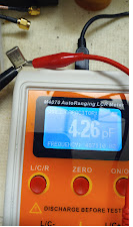Ohm the Capacity!
...actually, capacitance is measured in farads. Ohms are a unit of resistance.
Here is my Heathkit decade resistance box. Each knob varies the amount of resistance by units of one, ten, hundred, thousands or ten thousand of Ohms, thus the "decade" part of the name. Heath was a Michigan-based company that provided kits to make clocks, tube amplifiers, test and radio equipment, etc. This decade box is huge, at over a foot long and had a nice wood enclosure.
I bought this box at the Disabled American Vets (DAV) resale shop by my house for two dollars! It was already assembled. I knew it dealt with ohms, but I thought it might be for stereo speaker setup or something. Speakers commonly refer to ohms in their specifications. It just looked cool.
I like the idea of having a zillion resistors of different values in a convenient box. Did they have things like this for other circuit board components? Yep, I found a nice kit to solder of a bunch of capacitors. Instead of resistance in ohms, this deals with capacitance in farads.
Here are some brief photos of the assembly, which consisted of plunking in a small pile of capacitors:
I left the leads of each capacitor really long...they don't look like much, but capacitors store energy, so if you touch this board you'll get a nice sizzling feeling. A bunch of posts ago (
So You Wanna See Atomic Particles With Your Own Eyes Huh, Part 3) we dealt with larger capacitors and their deadly potential.
So nice and small. If can toggle between picofarads and microfarads.
As I stated in my previous post, only one of my new multimeters can measure capacitance.
Now instead of swapping circuits in and out by soldering I can just dial up different values of resistance or capacitance for testing.
Insulation
There is no such thing as a perfect insulator. If you hit any insulator with a high enough electrical charge, it will absolutely conduct electricity. Insulators have
less ability to let their internal electrical charges move, thus limiting their ability to conduct electricity. Again,
there is no such thing as a perfect insulator. Glass comes pretty close.
Way less resistive of an insulator is plastic, but it's good enough to insulate most electrical wiring. Think back to when we talked about transformers: the first coil never physically touches the second, electromechanical waves transfer electricity from one to the other. If you put high voltage through regular wires you can sometimes see glowing auras on the
outsides of the wires. Not good!
But what are we gonna do, use
glass as an insulator? Yes! Here is some of my utility (telephone) pole insulator collection. They're made of glass and the brown ones are ceramic.
Most of the glass insulators in my collection were made by HemingRay between 1848 to 1972. HemingRay was the world's biggest insulator manufacturer. The brown porcelain ceramic are by SBT and a couple are marked "Slater" which may refer to a couple different companies. The SBT are by Ohio Brass, and their logo is usually a letter B inside an O. They added an S and T to make SBT when it was a Silent Type insulator made to reject AM radio interference!
Here is a photo of a utility pole three blocks from my house. They don't use glass anymore, but they seem to have ceramic and fiberglass/plastic ones nowadays.
The above photo is weird because I was testing a telescope eyepiece that I was making out of old film projector lens parts.
People used to collect glass insulators a lot when they were still in use. Look around your neighborhood and imaging every boring brown modern plastic insulator was a blue or green or clear glass one! Back in the day you could go root around the base of any telephone pole and have a good chance of finding a discarded glass insulator.
I figured I'd never get a chance to find one in the wild, but then
this happened fifteen feet from my front door:
I rooted around and found the tiniest brown insulator in my collection and some cool hunks of metal used as brackets at the base of this pole. The utility company came and put a second pole next to this one and just bolted them together! It's still leaning like this, but I got to find cool parts under it.
Here is the "fixed" pole now:
Next time you're outside, poke around in the bushes near a utility pole: you never know what you'll find hiding in there.
No one will find me! Meow.

























